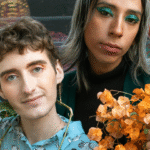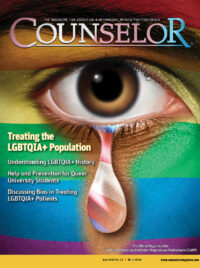Share
Resiliency, organization, and activism have a longstanding history in the LGBTQIA+ community. While people who identify as sexual or gender minorities have often faced social stigma, discrimination, and other challenges, the call to action has always resounded. As with other minority groups, the LGBTQIA+ community has always found a voice from which to speak that has influenced and created a strong, proud, vibrant community. As a person who works closely with this population and self identifies as queer, I understand intimately the importance of educated and affirmative care while serving this population.
While the prevalence of substance use disorders (SUDs) and abuse, mental health issues, and psychiatric disorders is much higher in the LGBTQIA+ population than those within sexual and gender norms (NIDA, n.d.; Cabaj, n.d.), there is evidence that people who were offered specialized groups—including affirmative, informed therapy sessions—typically have better recovery outcomes (Pachankis et al., 2015; Craig et al., 2021). Most of the LGBTQIA+ clients I have helped suffer from the wound of invisibility, and this is a population that craves visibility, acceptance, and understanding. As clinicians, truly “seeing” the people in front of us allows for repairs to be made after a lifetime of invisibility and disconnection from society and from themselves. Recovery is meant to help people uncover the truth of who we really are and live out loud in our authenticity.
Understanding LGBTQIA+ history and queer theory is so important in order to improve outcomes for this population. Outside of the Stonewall Uprising, many LGBTQIA+ historical figures and facts are not taught in schools or are simply unknown due to a lack of mainstream documentation (Aspegren, 2021; Baumann, 2019; Waxman, 2019). Affirmative care is helping our LGBTIA+ clients move toward self-acceptance and integration. This means helping these individuals to feel more comfortable with who they are and what they truly desire, thereby evoking a sense of pride to counteract the shame fostered by addiction. It means bringing forth hope by way of inclusivity, and helping them live and thrive from a place of community and authenticity. Understanding LGBTQIA+ heritage and helping our clients see that LGBTQIA+ people have a longstanding history of pride, plasticity, inclusion, and activism can ease the pain and suffering of internalized trans- and homonegativity, polarization, isolation, and cognitive dissonance and distortion. Providing historical education can inspire hope, connect folks to their community, and ignite resiliency in people who often feel rejected, unseen, and unheard.
Acronym Origins
Let us begin this brief but interesting journey into the history books of LGBTQIA+ people by starting with some of the popular acronyms of the community. “LGBTQIA2+” represents lesbian, gay, bisexual, transgender, queer/questioning, intersex, asexual/aromantic/agender, and the “2+” represents those who identify as two-spirit, nonbinary, or anyone that might fall outside the social constructs of sexual or gender norms. There is a very specific reason these letters fall in order within this acronym. Up until the mid-1980s, the acronym of “GLBT” was predominately used to represent gender and sexual minorities (Drescher, 2016). This history of the acronyms reorder goes back to a sustained trauma in the LGBTQIA+ world, which was the AIDS pandemic of the 1980s and 1990s. Lesbians came out in full force to help and ease the suffering in the community by donating blood, delivering meals, providing companionship, and offering some measure of nursing care to many men with AIDS as well as hitting the streets and playing a critical role in AIDS activism (Lister, 2020). Placing the “L” before the “G,” as is the norm today, “ . . . is a signal of respect, of solidarity, and of hope for a shared future of equality, justice, and love”(Drescher, 2016).
Pride Celebrations
Pride parties and celebratory parades sprout up across the world during the month of June to honor the June 28, 1969 Stonewall Uprising, which ignited the gay rights movement (Ennis, 2015). Pride Month itself is rooted in opposition, freedom, and liberation from marginalization based on sexuality or gender. Additionally, “PRIDE” is also an acronym for “Personal Rights in Defense and Education,” an organization founded in 1966 in Los Angeles, California to aid LGBTQIA+ folks needing legal defense from arrests based on sexual orientation in the 1960s (Zonkel, 2022). Specifically, these were arrests made at Black Cat Tavern, where dozens of LGBTQIA+ people were arrested for public lewdness after displaying same-sex affections during a New Year’s Eve celebration (Zonkel, 2022).
The History of the Rainbow Flag
Have you ever wondered about the origins of the rainbow flag, which is a marker and representation of LGBTQIA+ people? The Pride flag was adopted in 1978 in San Francisco, California (Morgan, 2019) and can be traced back to Harvey Milk, the famous San Francisco city Supervisor, and his friend Gilbert Baker. Baker moved to San Francisco following his honorable discharge from the Army, and there he befriended Milk, who challenged him to create a symbol for what was then more commonly called the “gay community” for the San Francisco Pride Parade (Morgan, 2019). The original rainbow flag used eight colors to represent different spiritual and emotional aspects of the psyche:
- Hot pink (later removed) represented sexuality
- Red represents life
- Orange represents healing
- Yellow represents sunlight
- Green represents nature
- Turquoise (later removed) represents magic and/or art
- Indigo (later changed to royal blue) represents serenity/harmony
- Violet represents spirit
Today, you are likely to see a version designed by Daniel Quasar that adds a triangular chevron to one side, with colors honoring the transgender community as well as people of color (“The progress,” n.d.).
Why Understanding LGBTQIA+ Heritage is Important for Counselors
There have been advances in LGBTQIA+ rights and today individuals are experiencing more social acceptance. However, the stigma—both internal and external—continues to be the greatest barrier facing sexual and gender minorities. According to the American Psychiatric Association, many LGBTQIA+ people might develop an internalized homo/transphobia that can contribute to issues with self-acceptance, negative self-perception, increased anxiety, difficulty forming intimate relationships, and depression (Cabaj, n.d.). LGBTQIA+-specific clinical groups can help folks address internalized oppression and alleviate symptoms of shame and disconnection. Externally, stigma and the influence of societal and cultural views can further deepen the wound of “otherness.” Understanding the history of the LGBTQIA+ community, both within society and within the profession of therapy and counseling, is necessary in bringing context to treatment planning. There are very unique issues that must be addressed through an affirmative approach.
Individuals in this community have a rich and vibrant history of overcoming adversity and engaging resiliency in times of injustice and peril. Helping folks recognize a space of esteem and confidence in who they are and the legacy behind them can greatly influence outcomes for those facing SUDs and mental health issues. Being equipped with historical content and context about LGBTQIA+ individuals’ place in history and in the world itself can provide a safe, educated space for folks to begin to live authentically with pride in who they are. For instance, transgender people have long been revered by many different cultures and societies as higher beings that possess both masculine and feminine attributes that allow them to operate outside of a binary world. Kuan Yin, or Guan Yin, the genderfluid spirit of compassion in Buddhism (also known as the goddess of mercy), goes by different names in different places, including “Avalokiteshvara” in India, “Gwan-eum” in Korea, and “Kannon” in Japan (New World Encyclopedia, n.d.). Transcending gender identity, Kuan Yin appears in whatever form is necessary to help people in need: sometimes female, sometimes male, sometimes androgynous.
Our practices grow in response to deepening our understanding of gender and sexuality. Psychoeducation is essential to those who are seeking help to manage and uncover social, cultural, and religious traumas associated with oppression, toxic shame, and marginalization. Minority stress theory (Meyer, 1995) has shown us how living in a society that normalizes heterosexual and cisgender identities results in distress and mental health issues for many minority identities. By encouraging LGBTQIA+ clients to connect with their rich and colorful history, we can help promote a sense of value, belonging, confidence, esteem, and (most of all)pride in who they truly are. Motivational interviewing and mirroring can restore and reassure folks that who they truly are is all they need to be. Queer people’s place in the world has always been and will always be. Having clinicians who are educated and well-informed on LGBTQIA+ issues can make a huge difference in all forms of therapy. When counselors are armed with affirming practices, more folks can be treated effectively, authentically, and without the risk of bias—something everyone deserves in their journey to mental wellness.
References
- Aspegren, E. (2021). Kids aren’t learning LGBTQ history. The Equality Act might change that. USA Today. Retrieved from https://www.usatoday.com/story/news/education/2021/03/06/lgbtq-history-equality-education-act-teachers/6648601002/
- Baumann, J. (2019). Fifty years after Stonewall, we’re still disagreeing about what happened there. That’s why the archives matter. Time. Retrieved from https://time.com/5579971/christopher-st-stonewall-history/
- Cabaj, R. P. (n.d.). Best practice highlights: Lesbian, gay, bisexual, transgender, and people who may be questioning their sexual orientation or sexual identity (LGBTQ). Retrieved from https://psychiatry.org/File%20Library/Psychiatrists/Cultural-Competency/Treating-Diverse-Populations/Best-Practices-LGBTQ-Patients.PDF
- Craig, S. L., Eaton, A. D., Leung, V. W. Y., Iacono, G., Pang, N., Dillon, F., Austin, A., Pascoe, R., & Dobinson, C. (2021). Efficacy of affirmative cognitive behavioral group therapy for sexual and gender minority adolescents and young adults in community settings in Ontario, Canada. BMC Psychology, 9, 94.
- Drescher, E. (2016). GLBT? LGBT? LGBTQIA+? What’s in a name? Retrieved from https://medium.com/the-narthex/glbt-lgbt-lgbtqia-whats-in-a-name-a5608849c9fa
- Ennis, D. (2015). Stonewall Inn declared NYC landmark. The Advocate. Retrieved from https://www.advocate.com/stonewall/2015/06/23/stonewall-inn-declared-nyc-landmark
- Lister, K. (2020). The lesbian ‘blood sisters’ who cared for gay men when doctors were too scared to. Retrieved from https://inews.co.uk/opinion/comment/the-lesbian-blood-sisters-who-helped-save-gay-mens-lives-235100
- Meyer, I. H. (1995). Minority stress and mental health in gay men. Journal of Health and Social Behavior, 36(1), 38–56.
- Morgan, T. (2019). How did the rainbow flag become an LGBT symbol? Retrieved from https://www.history.com/news/how-did-the-rainbow-flag-become-an-lgbt-symbol#:~:text=The%20rainbow%20flag%20was%20created,San%20Francisco’s%20annual%20pride%20parade.
- National Institute on Drug Abuse (NIDA). (n.d.). Substance use and SUDs in LGBTQ* populations. Retrieved from https://nida.nih.gov/research-topics/substance-use-suds-in-lgbtq-populations
- New World Encyclopedia. (n.d.). Guan Yin. Retrieved from https://www.newworldencyclopedia.org/entry/Guan_Yin
- Pachankis, J. E., Hatzenbuehler, M. L., Rendina, H. J., Safren, S. A., & Parsons, J. T. (2015). LBG-affirmative cognitive-behavioral therapy for young adult gay and bisexual men: A randomized controlled trial of a transdiagnostic minority stress approach. Journal of Consulting and Clinical Psychology, 83(5), 875–89.
- “The progress pride flag.” (n.d.). Retrieved from https://www.vam.ac.uk/articles/the-progress-pride-flag
- Waxman, O. B. (2019). As more states require schools to teach LGBTQ history, resources for teachers expand. Time. Retrieved from https://time.com/5747670/lgbtq-history-resources/
About Me
Mell McCracken, CADC II, RACS, ASAT, (they/them) is the executive director at No Matter What Recovery Center in Los Angeles. They are a fierce is a fierce advocate for healing and transformation through substance abuse counseling, sex addiction therapy, and treatment program development. They have extensive expertise in empowering individuals to overcome their struggles with addiction and navigate the complexities of chemsex in the rainbow community. They are a nationally and internationally recognized LGBTQ+ educator, co-author, and treatment provider.











 Counselor Magazine is the official publication of the California Association of Addiction Programs and Professionals (CCAPP). Counselor offers online continuing education, article archives, subscription deals, and article submission guidelines. It has been serving the addiction field for more than thirty years.
Counselor Magazine is the official publication of the California Association of Addiction Programs and Professionals (CCAPP). Counselor offers online continuing education, article archives, subscription deals, and article submission guidelines. It has been serving the addiction field for more than thirty years.